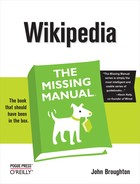As a Wikipedia editor, you need to know how to use the pages where editors interact and collaborate with each other. Even if you want to focus mostly on improving articles, you’ll find that discussing those improvements with other editors before, during, and after your actual article work goes a long way in making sure your changes are accurate and don’t get reverted later.
Dealing with vandalism (Chapter 7) and content disputes (Chapter 10) also require you to use article and user talk pages. As a Wikipedia editor, you’ll communicate with other editors on article talk pages and user talk pages—including your own. You can also, if you wish, communicate directly with other editors by email and in online chat rooms.
All these methods of communication involve standard procedures and norms of conduct. If you don’t follow them, other editors are much more likely to ignore what you’re saying, as valuable as it may be. This chapter spells out those processes and norms so you can make your points easily and clearly.
When you post a comment to a talk page, you must always sign your comment. Other editors need to know who posted what, and when, so they can follow the thread of a conversation, post on a user talk page if appropriate, and even just know whether a posting is worth responding to. (A comment that’s more than a month old is presumed to be of historical interest only if it’s no longer part of an ongoing discussion.)
In Wikipedia, signing has two parts: your signature (sometimes called “sig”), which is a composite of one or more links (to your user page, user talk page, or user contributions page), plus the time and date that you save your edit. Here’s an example of what signing your comment would look like: YourUserNameGoesHere talk 22:04, 11 November 2007 (UTC). If you click on the first, long word, it leads to the user page; if you click “talk”, it leads to the user talk page.
Signing a comment is easy: Simply put four tildes at the very end of your comment, without spaces between the tildes. (A tilde looks like this: “~”; on American keyboards you find it in the upper left.) If you type only three tildes by mistake, you add only your user name, not the date and time you posted your comment. If you type five tildes by mistake, you leave the date and time but not your user name or a link to your user talk page.
Don’t start a new line or paragraph when you sign your comments. At the end of the body of your comment, just add a space or two, or a dash or two, or both, for separation, and then add the four tildes. (Extra lines for your signature just take up space on a page, and adding them is the mark of an inexperienced user.)
In edit mode, you can also sign by using a button on the edit toolbar (the row of icons just above the edit box). Clicking the button that has cursive writing on it inserts two hyphens and four tildes (--~~~~) in the text you’re editing. (Make sure your cursor is where you want your signature to appear—the button isn’t smart enough to figure that out itself.)
